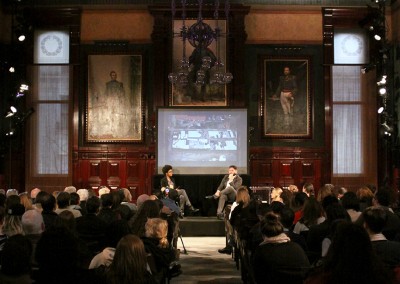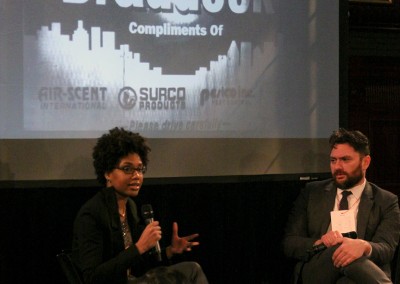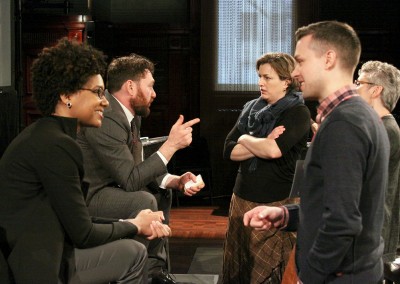Art + Education: Expanding Access & Equity
Exchange, Part 2
In this second exchange, John Abodeely and LaToya Ruby Frazier discussed current developments working to create greater equity and access in American education, and the changes that still need to occur for this equity to materialize. Debate about the roles and responsibilities of artists and administrators, and the need to challenge the status quo culminated in an impassioned inquiry into how every American child can receive the education he or she deserves.
John Abodeely is the Deputy Director for the President’s Committee on the Arts and Humanities, an advisory committee for the White House on cultural issues. The team of around 40 committee members works to address policy questions on arts and humanities education and cultural exchange. Under the Obama administration, John has helped initiate Turnaround Arts, an educational program targeting schools performing in lowest five percent. Turnaround aims to improve student’s academic success with a holistic integration of an arts-based curriculum.
LaToya Ruby Frazier is an artist and assistant professor of photography at Chicago’s School of the Art Institute. She started photographing her family and hometown at 16, and sees her work as blurring the line between self-portraiture and social documentary. An ART21 New York Close Up artist, LaToya investigates the social and economic struggles that accompanied industrialization and then deindustrialization in contemporary America. By examining her own family’s generational relationships, her work shines a light on blind spots of prejudice and abandon.
LaToya Ruby Frazier – “I started out making my work as a teenager who had a lot of questions and concerns about the visibility and the representation of people like me, and the women in my family and from my community… When we talk about Braddock, and even when you hear about Braddock today in the current media… you only hear the grand narratives and stories about Andrew Carnegie, the industrial capitalist, JP Morgan, Vanderbilt…
So as an artist, my work sits at this intersection of the working class and the creative class, and trys to speak to some of these areas that we don’t want to address, like race and class…
It’s really a fundamental issue for me because you know we spend so much time talking from the top down to people, and in reality I think those that have been marginalized and those that took the heaviest hit since the collapse of the industry, have the most education to give. So perhaps instead of a panel of the experts and the educators and the policymakers, instead of them being at the panels, perhaps it should be the people that we never hear from, we never see in the media, the ones that are never getting access to the resources – perhaps they should be on the panel and we should be listening to them. And that’s a dream and a hope of mine…”
LaToya’s family friend, Isaac Bunn lives in the last remaining house on his block in Braddock. The town deemed the area worthless vacant land and started using the space for the industrial storage of huge white bags filled with shredded rubber tire. LaToya’s aerial photo of Isaac’s house shows it surrounded by rows and rows of white waste. The image was featured in her 2014 show at the Seattle Art Museum, LaToya Ruby Frazier: Born By a River.
LaToya Ruby Frazier – “Instead of me talking, Sandra [Sandra Jackson-Dumont at the Seattle Art Museum] flew Isaac in. Instead of it being a docent… he’s leading this opening night, talking to people about what’s going on with his property and his home in his story.
I mean how often do we see the museum allow the person from the street, right, that’s invisible, come in and actually lead a discussion. It was probably the most important, crystallized moment for me to be able to do that for Isaac, because it’s so important. What’s happening to him is like the history of this country.”
Practical capabilities of affecting change through art
LaToya Ruby Frazier – “The thing that is frustrating is that with the media saturation and the way that only one side is always revealed, it’s not so much it being trapped in a cultural sphere, because it’s not even being revealed at all…
Everyone emigrated and lived here [in Braddock], no matter if you were from Norway, Ireland, France; people lived here… So this is an American story. You know this is not a black thing, this is an American thing and it’s a global issue…
I know how to see the problem and document the problem, but my issue is unpacking the whole system and understanding how it works. And this is what your skills are and your whole vision and everything you can speak to….”
John Abodeely – “Well that was what I was getting at. For awhile when I was working in American City Arts in the Kennedy Center in Washington DC, we were doing this mapping of the educational system because we were trying to ask the question of what our constituents could and should be doing to improve access to arts education… The first place we had to start was, we just had to say, “Who are all the actors in education, and what’s their sphere of influence in arts education?”
…And then we mapped out for each of those people, what they could do for arts education, what they could do for access to arts education. Our idea was that if you don’t understand the system you’re working in and all the different decision makers and which role you’re playing in there, as well as your unique sphere of influence, you can’t have an impact. You can’t possibly have an impact.”
Utilizing innovation and revolution
John Abodeely – “I worry that from my vantage point, which is as part of an agency that’s fairly high up on the arts ladder in the federal—in the presidential administration—how much we can actually affect. You know one of our major partners is the US Department of Education, they’re a major investor in Turnaround Arts, they’re a thought partner, they have organized calls for schools to get schools involved, and we work with them on where we can find space for the arts inside all of their programs…
But I worry that we’re approaching it from a perspective of what the administration can do and we’ll never be revolutionary enough or innovative enough. We’ll always have to fit within the administration, you know. No matter how revolutionary we get, it has to stay palatable in the context we work in. And it worries me that in the artistic or cultural sphere, you’re invited to be more revolutionary but then you end up having less influence. Whereas people think of us as having this enormous influence, it’s the president and all this stuff — but we can only go so far.
Whereas you’re in sort of a similar conundrum but different, which is that you can be as innovative and crazy as you want — and I think it sounds pretty revolutionary to have one of the subjects of your narratives telling his story in front of your artwork. That sounds, unfortunately, pretty unique, and pretty powerful. But then how far of an audience does that kind of revolutionary act have?”
LaToya Ruby Frazier – “It certainly didn’t go far enough, but you keep working and you keep trying and you keep building. I’m at this intersection and fork in the road where the next step is a partnership and finding the right people. Cause this is a time sensitive, urgent issue.”
Reaching beyond traditional educational structures
LaToya Ruby Frazier – “They’re taking arts out of school. They’re making art school too expensive. Your parents don’t have the job. You have to go out there and work. There’s just all these cracks, and I think that if people were dealing more with the parents and looking at people who may have had felony charges or might have a disability or may be single-parent household, we would be able to give more power and agency…”
John Abodeely – “I think in the administration and in public discourse there’s a lot of debate about who’s responsible for what, and the scariest thing to me is that it’s challenging for existing power structures to take responsibility – enough responsibility to say, we’ve sequestered the wealth and the opportunity. Right? That seems like a pretty epic battle to me to take on. It’s worth doing. It’s the only fight to have. It’s the only fight that really needs to happen, but it’s huge.”
Equal access
LaToya Ruby Frazier – “Except for an artist like me, because of all the politics, and all this talk of revitalization and how wealth is moving but only amongst the wealthy, I’m falling through a crack and not being able to use all this energy and passion and skill that I have to help them. I’m also watching – through nonprofit organizations – certain populations being discriminated against. I want to know how come we as a culture don’t address that. A nonprofit can say, ‘this is our criteria. These are the demographics we’re interested in…’
I’m wondering, where are the programs to let people know how to do that, and why does it keep being put in this bottlenecked thing of only if you have a BA or BFA or an MFA? I mean this should be taken to the streets.
I’m in the churches. I’m sitting in some of these meetings where people are trying to keep their homes. I’m trying to help them rewrite stuff. I’m not just making artwork. I’m in all these different places. And I’m wondering, if I can do that as an individual, certainly the government can and programs can. So where’s it at?
Or how can we make something like that happen? ‘Cause I know you’re not responsible for making all these things come into existence. But how can we make that happen, right?”
John Abodeely – “You know, we have a lot of really great artists in our community. We have Sarah Jessica Parker and Kerry Washington and Forest Whitaker, and they’ve each adopted a Turnaround Arts school. And when we expanded the program, we had artists calling us. Elton John who was like, I want to do this. Just give me a school and help me do this… I should add about the artists that it’s not icing on the cake – those artists are probably our most powerful factor in changing the feel of those schools, and the sense among our students and our families about what’s possible for them, and what they should ask for and expect.
They’re not just eye candy and they’re not just press opportunities, although that’s helpful; it changes the narratives about our schools…
The idea that there is energy and impact right now in transforming the lives and experiences of the students that we can reach right now, my hope is that we’re altering the conversation about what’s actually possible in education, what power structures are willing to do to make that kind of change…
I’m glad that we rewrite the standards. We need good standards. But I don’t think that rewriting the standards for all of the time and energy that it takes, is going to alter the lives of Jared in the Irish Channel in New Orleans, who was this close to being in jail before somebody put a trumpet in its hands and said go lead the drum line.”
Saturday, February 21st 2015
10:30 a.m.
Topics discussed:
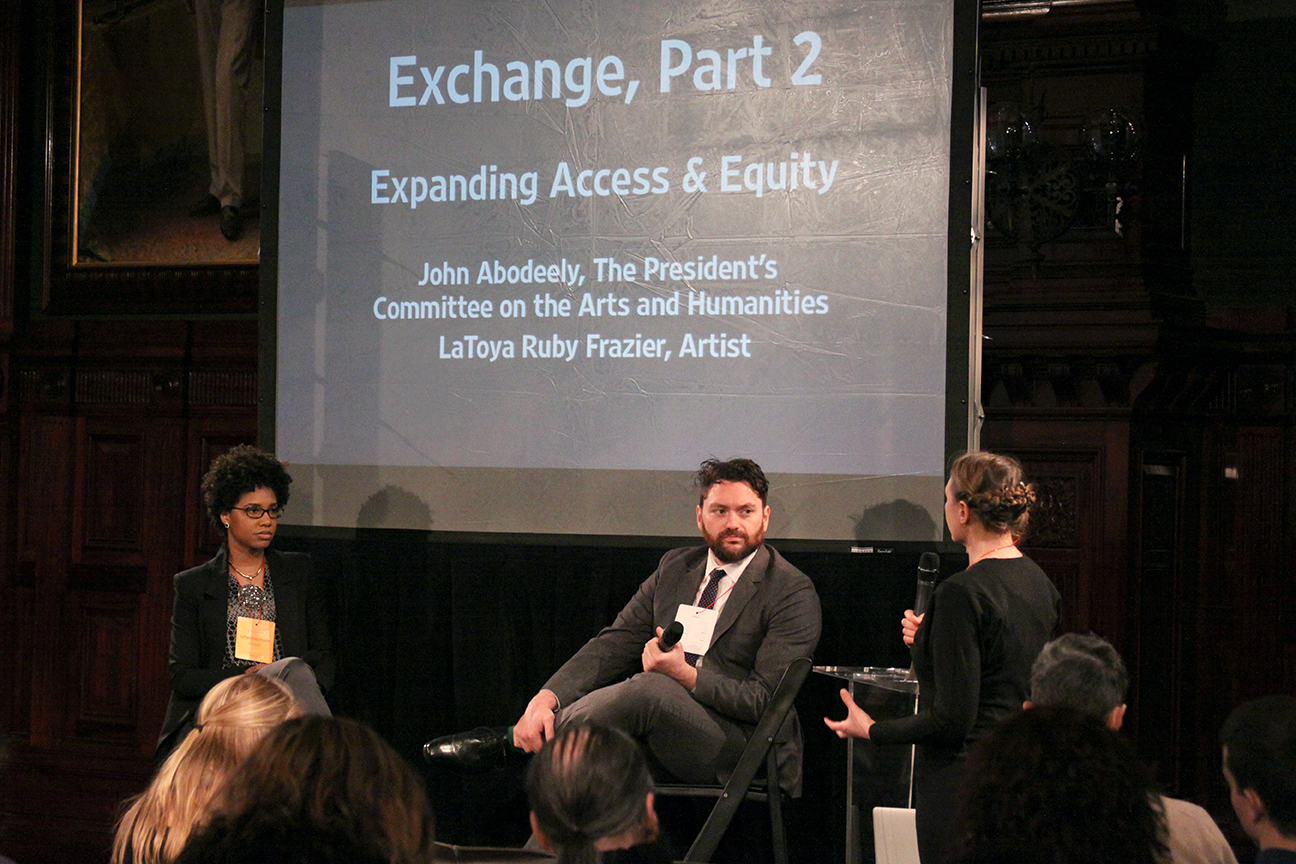
I started out making my work as a teenager who had a lot of questions and concerns about the visibility and the representation of people like me, and the women in my family and from my community...
— LaToya Ruby Frazier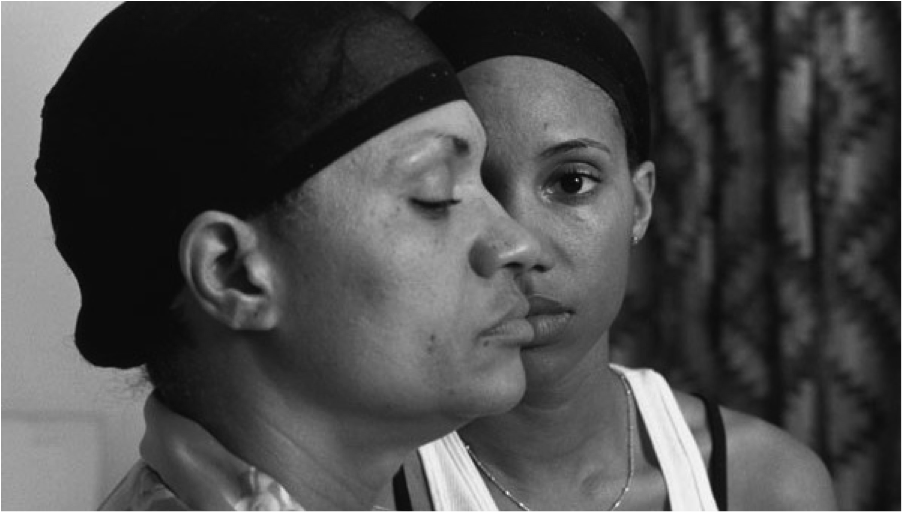
LaToya Ruby Frazier. Momme, 2008 from The Notion of Family (Aperture, 2014)

LaToya Ruby Frazier. The Bunn Family Home.

I think those that have been marginalized and those that took the heaviest hit since the collapse of the industry, have the most education to give.
So perhaps instead of a panel of the experts and the educators and the policymakers, instead of them being at the panels, perhaps it should be the people that we never hear from, we never see in the media, the ones that are never getting access to the resources – perhaps they should be on the panel and we should be listening to them.
— LaToya Ruby Frazier
If you don’t understand the system you’re working in and all the different decision makers and which role you’re playing in there, as well as your unique sphere of influence, you can’t have an impact.
You can’t possibly have an impact.
— John Abodeely

My hope is that we’re altering the conversation about what’s actually possible in education, what power structures are willing to do to make that kind of change…
— John Abodeely



